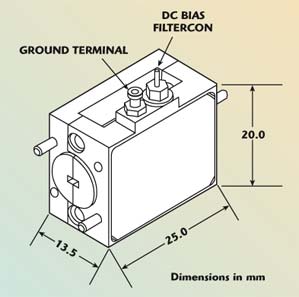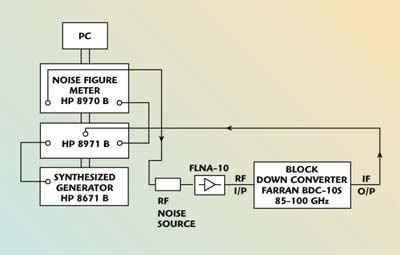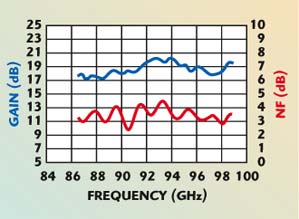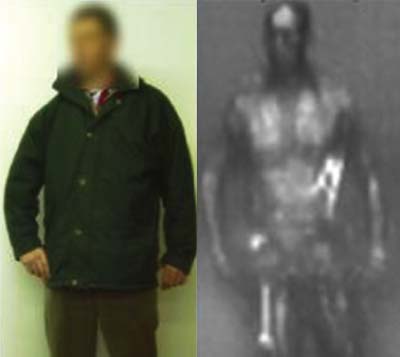 | |||
Traditionally products operating at millimeter-wave (mm-wave) frequencies could only be fabricated using waveguide technology, which restricted their application to low volume scientific applications such as radiometers and plasma diagnostics. Waveguide components suffer the disadvantages of high manufacturing complexity, large volume and high cost when dimensions become small at frequencies such as these. This has been a major obstacle for mm-wave component companies to supply to mainstream markets.
However, recent technical breakthroughs in monolithic microwave integrated circuit (MMIC) materials now permit ICs to process signals at frequencies up to and beyond 100 GHz. Molecular beam epitaxy (MBE) technology has enabled control of material deposition on an atomic scale, resulting in pseudomorphic high electron mobility transistor (pHEMT) and more recently metamorphic HEMT (mHEMT) technology. The availability of these devices has created a stimulus for the growth of commercial applications for mm-wave technology.
Engineers and manufacturers are now becoming aware of the advantages that MMIC technology has over waveguide-based components. Mature MMIC processes now mean that the technology can be used for high reliability applications, such as in the automotive and space arenas. In fact, many automobiles now contain a mm-wave sensor utilizing MMICs for collision avoidance applications. MMIC components can now be manufactured in sufficient volume, at a relatively low cost, and can be small and light. As far as mm-wave low noise amplifier (LNA) components were concerned before the advent of MMIC components, there was no alternative. Consequently, their development has had a major impact on system performance at these higher frequencies, opening even more avenues for mm-wave systems.
A direct result of this improved technology is the FLNA-10 Series of low noise amplifiers. Based on gallium arsenide (GaAs) MMIC devices, these amplifiers come packaged in a double-plated gold and nickel housing made of aluminum alloy. They are designed for high performance compact systems operating at the 85 to 100 GHz frequency range. They are particularly suitable for communication and radar receivers, and instrumentation systems where the low system noise figure is crucial. The LNAs feature a lightweight design, allied to compact dimensions, as shown in Figure 1.
 | ||
| Fig. 1 The FLNA-10 Series mechanical outline. | ||
The LNAs are offered in two categories, namely, standard and custom built. The custom built amplifiers are offered in various RF interfaces, including standard waveguide or coax connectors, for convenient system integration. Optional input and output integrated isolators are available to further improve the port return loss.
Technical Specifications
Table 1 shows the operational characteristics of the FLNA-10 Series. The LNAs are offered with the following specifications:
Ports: modified WR-10 UG-387/U-M
DC Voltage: 3 to 6 V/30 mA typical
Dimensions: 20 by 25 by 13.5 mm.
 | ||
Performance Measurement
Figure 2 shows the test set up for measurement of the noise figure and gain of the low noise amplifiers. The test equipment used consists of a Hewlett Packard noise figure system, an RF noise source and a Farran block down converter BDC-10S. This system was calibrated first without the FLNA-10 amplifier, which was then added to the set up shown. Measurement of the noise figure and gain was done using the Mode 1.7 Swept IF on the noise figure system. The typical performance of a standard FLNA-10 is shown in Figure 3. The results show a noise figure of 2.5 to 4.5 dB across the 85 to 100 GHz frequency range.
 | ||
| Fig. 2 The test setup for measuring the LNA’s noise figure and gain. | ||
 | ||
| Fig. 3 Typical performance of a standard FLNA-10 amplifier. | ||
As well as the standard products outlined, which provide the specified performance over the full bandwidth indicated, the company also offers customized solutions for specific application requirements. Improved performance may be available over narrower bandwidths depending on chip availability, and additional gain can also be provided by cascading stages.
Applications
Low noise amplifiers from the series can be used for many emerging applications at W-band, including radar front ends, wideband radiometry and transceiver sub-assemblies. The low noise amplifier is a key component of these systems, facilitating high dynamic range in the overall system, which, for example, allows detection of far-away objects in radar applications.
Figure 4 shows an example of a real-life application of FLNA-10 amplifiers. They can be arranged in a stacked module that offers up to 60 dB gain and can integrate filters and detectors in the same package. This high gain detection module for W-band radiometer applications can be used for front ends and arrays.
 | ||
| Fig. 4 A stacked module that is part of a 94 GHz mm-wave imaging camera. | ||
The displayed module is part of the company’s 94 GHz millimeter-wave imaging camera that screens for the presence of threat objects (weapons and explosives) hidden under a subject’s clothing (see Figure 5). Operating in the mm-wave region has particular merits due to the potential for systems to penetrate cloud, fog, smoke and dust, while providing high levels of reliability, image resolution and relatively low cost. Farran Technology has obtained several novel patents in this emerging area.
 | ||
| Fig. 5 The results produced by the 94 GHz mm-wave imaging camera. | ||
Conclusion
The development of MMIC technology is opening a broad window of commercial possibilities for microwave applications. As the development of the FLNA-10 Series shows, Farran is one of a small number of companies with the necessary technology and know-how to capitalize on this growing market demand, both for subsystem and system-level products. Additional information may be obtained via the company’s Web site or via e-mail at sales@farran.com.
Farran Technology Ltd.,
Ballincollig, County Cork, Ireland
+353 (0) 21 4872814,
www.farran.com
